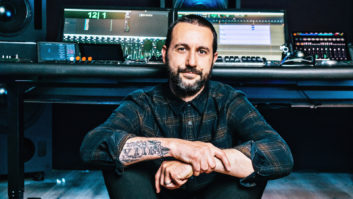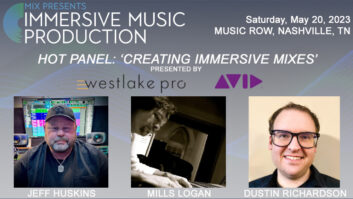Composer Mark Isham kick-started his new record label, MIM, with an adrenaline-charged film score for the 2011 movie The Mechanic. Isham tapped veteran engineer Jason LaRocca to mix and master the composer’s hybrid creation comprising elements of rock, electronic and orchestral music. “The [original 1972] score was a jazzy, small orchestral ensemble score,” LaRocca explains, “and very different from the one we did. [Laughs] Mark went in a very particular direction with it: lots of metal, detuned guitars, big string sections and giant drums. The main challenge was trying to get it all to speak as one coherent piece, and to make those worlds sound like they made sense together and [have an] impact against car crashes and gunshots. We had our work cut out for us in terms of the competition that surrounded us in the final dub.”

Jason LaRocca seated at the Trident 90 analog console in Clockwork Labs’ “A” room. Photo: Gary Copeland
LaRocca mainly mixes in Clockwork Labs in Van Nuys, Calif., a private facility owned by producer/engineer Hector Delgado. Assisted by Delgado, LaRocca worked on The Mechanic in Clockwork Labs’ “A” room, which features a 40-channel Trident 90 analog console with 32 channels of Apogee AD/DA conversion; Genelec 1037b mains with a Genelec 7070A subwoofer; and Blue Sky mains and surrounds. For additional recording duties, LaRocca used Royer and Neumann mics; Eisen Audio and Grace Design mic pre’s; Empirical Labs Distressors; and an Avalon Vt-747sp compressor/EQ. LaRocca notes that the mix was “very plug-in intensive [with] lots of processing,” and that he used UAD-2, Sonnox and Waves plug-ins, as well as Native Instruments Guitar Rig 4, PSP VintageWarmer, and Steinberg Reverence and Nuendo 5’s parametric EQ.
“I used Nuendo 5 for all internal 5.1 mixing, with the Trident 90 used for select analog treatment of mix elements,” LaRocca says. “We can throw anything out onto the board or leave it in the box—however we want to do it. My print masters and stereo fold-down all work within the same system. I do video on a separate system.
“It was a pretty long score—almost 70 minutes. Mark gave me between 100 and 200 tracks of synths and the orchestra. On a couple of cues, elements would fly in at the last minute; orchestra files would show up [from Prague] and we’d have to throw them into the cue and mix them and print them out.” Isham and LaRocca worked with the film’s sound designers “to some degree. We would get a pretty good idea of the effects so we knew we had to add another 20 drum tracks to make them impactful enough. I think we were probably mixing at about 15dB below reference volume at one point because we were printing so hot. It sounded great on the dub stage.”







